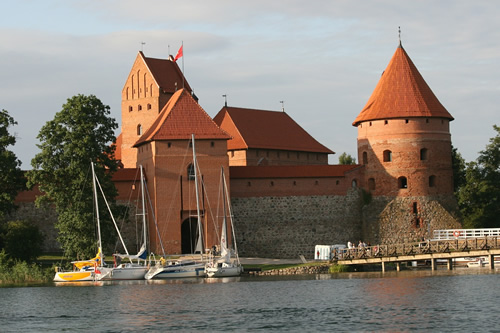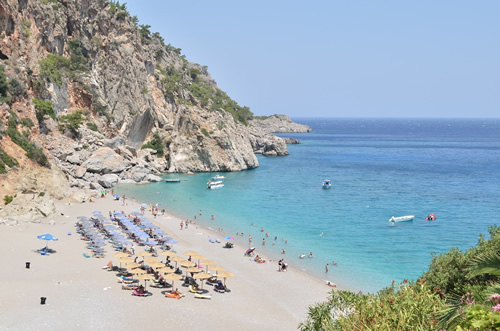Budget Travel in the New Eastern Europe
Tips for a Cheap Trip as Prices
Rise
By Tim
Leffel

|
|
A castle in affordable Lithuania.
|
Eastern Europe, once a backwater area
recovering from communism, has become, in many locations,
the hottest of hotspots. For travelers on a budget who aren’t
paying attention this could mean some bad surprises. For
others it presents opportunities.
When I researched the revised edition
of my book The World’s Cheapest Destinations, I found
the picture in Eastern Europe to be far different than when
I researched the first edition. Prague is getting
almost as expensive as Western Europe, Budapest is coming on strong,
and Romania’s tourism business is increasing by leaps
and bounds. (NB: You can compare the cost of living of various cities in Eastern Europe and worldwide via the crowdsourced site Numbeo.com.)
Macroeconomic factors are at
play here. As Eastern European countries have
aligned with the EU, they have become much pricier in dollar
terms. Also, the proliferation of budget flights within
Europe has resulted in a huge influx of visitors from the
western half of the continent.
What follows are a few of the most
notable changes and how they could affect your travel plans.
Prague Is the New Paris — with
Prices Beginning to Match
When the Velvet Revolution took
hold in 1989 and Havel the poet became president the
following year, Prague suddenly became the place to be.
It was a wild city of opportunity then, a place shaking
off the dust and leaping forward into the modern world.
That transformation is complete — to the point, some
would say, that the city has become a kind of gothic
Disneyland. In the beginning Prague was being compared
to Paris of old, a place where writers and creative types
could flourish while living cheaply. Now Prague is being
compared to Paris for other reasons: a deluge of summer
tourists and lodging prices that keep climbing.
While in the early 1990s it
would have been hard to find one hotel that could satisfy
a picky upscale traveler, now there are over 50 properties
that routinely list rooms for $200 or more per night.
Hostel beds in the city center can go for as much as hostel
beds in Dublin or Berlin (See hostelworld.com for comparisons). The historic center is full
of pubs and restaurants geared to tourists, and in summer
the Charles Bridge is now as crowded as the square in
Venice.
It is still a magical place,
of course, but travelers on a budget should quickly head
out to the rest of the country. Since 90 percent of visitors
to the Czech Republic reportedly never spend a night
outside of Prague, becoming one of the minority ensures
lower prices and smaller crowds. Become a real Bohemian
and you will be richly rewarded. Or cross the border
to Slovakia, where tourism is still finding its feet,
and there’s a fraction of the competition for rooms.
Budapest and Krakow Are
Close Behind
Prague is not the only city
that has benefited from a huge influx of tourists and
development. The Polish city of Krakow and the Hungarian
city of Budapest are packed with visitors right now and
lodging prices are again rushing to match those in Western
Europe. Budapest now has a posh Four Seasons hotel and Krakow is pricier than most
U.S. cities.
However, while the Polish countryside
may not have a whole lot to occupy travelers, Hungary
has a wealth of attractions outside the city. There are
the wineries in the “Valley of the Beautiful Women,” interesting
castles, lake retreats, and plenty of places to take
in some great folk music performances. As in the Czech
Republic, simply getting away from the tour bus routes
will result in major price drops and a more authentic
experience. This is not to discount Budapest, however.
Many travelers rank it as one of their favorite cities,
so it’s worth dodging the crowds and spending some
time in the capital. Zip around on the cheap metro and
trams for sightseeing, then soak for hours at one of
the famous spas.
The Window is Still Open
in Bulgaria and Romania
Two countries that are a bit further
behind in EU alignment, Bulgaria and Romania, offer the
best value in Eastern Europe at this time. Romania’s
tourism business is one of the fastest growing in the
world, but from a very low base. In both these countries
you can still find beers for under $2 dollars, $5 bottles
of wine, meals for a few bucks, and a private room for two for $20+, depending upon the season, of course.

|
|
A beach in affordable Bulgaria.
|
Most people think of Count Dracula
when they hear “Transylvania,” but this mountainous
region in Romania is about more than vampire legends
and Vlad the Impaler. For now, it’s still an uncrowded
area of picturesque villages, medieval castles, pretty
churches, and great hiking opportunities.
Bucharest will probably never
top the list of the world’s great cities, but it
does have a lot going for it and prices are reasonable.
Hostels compete hard for customers, often throwing in
breakfast, Internet access, beer, or even cigarettes!
There’s also a good reason to visit Romania in
the winter: some of the cheapest skiing on the continent.
Bulgaria is one of the cheapest
places to travel in Europe. Mid-range travelers can still
find impressive hotel deals throughout the country and
hostel beds range from $8-$20. You can traverse
the entire country by train or bus for under $20. An
all-day public transport pass in the capital, Sofia, costs about
a dollar. Museums charge foreigners four times what the
locals pay, but when a ticket costs you $2-3 it’s
hard to complain.
Bulgaria offers a lot of country
scenery and hiking trails, the Black Sea coast, and the
historic capital Sofia. While it may not have the “wow” factor
of Budapest or Prague, prices are a bargain and many
travelers end up exploring the city for a week or more.
These aren’t the only
options of course. Montenegro declared independence
and prices are noticeably lower than in the new uppercrust
hotspot of neighboring Croatia. The Baltic states, such
as Estonia, are still far from being flooded with tourists.
Countries such as Albania, Belarus, Macedonia, and Lithuania
are nowhere close to gracing the covers of major travel
magazines — yet.
If you’re planning a trip
to Europe anytime soon and are going to head east, do
some research and find out which way the wind is blowing.
Progress — for better and for worse — makes the
region a moving target.
Tim Leffel is author of several books, including A Better Life for Half the Price: How to prosper on less money in the cheapest places to live. See more on his Cheapest Destinations Blog.
|
